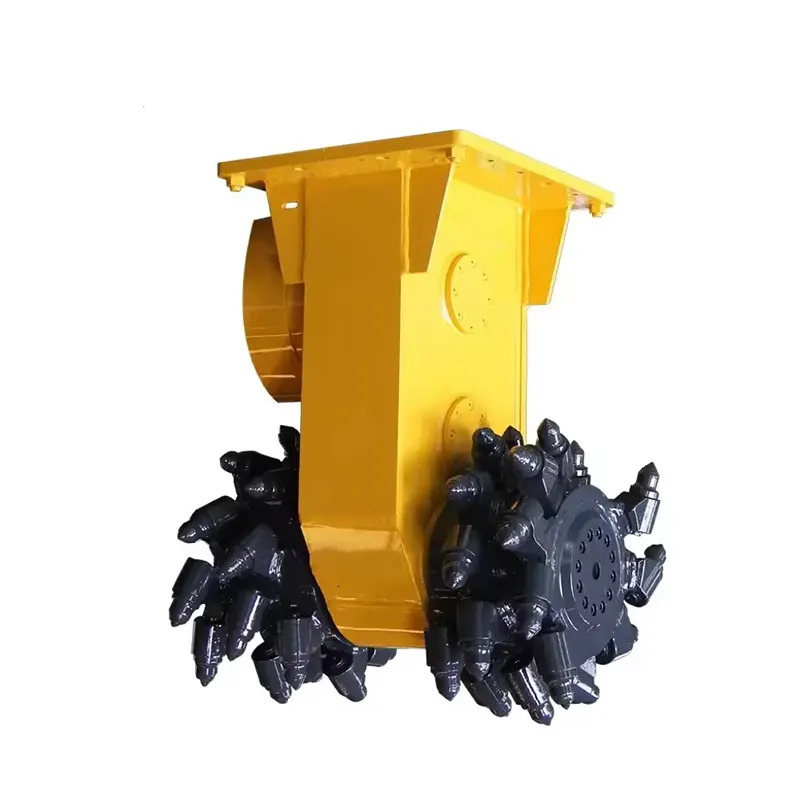The SLMC series excavator drum cutter is built for precision and power, making it the perfect tool for tough excavation tasks. Whether cutting through rock, concrete, or asphalt, this drum cutter for excavator ensures efficient, accurate work.
| MODEL | SLMC-DC80 | SLMC-DC150 | SLMC-DC240 | SLMC-DC350 |
| Excavator Tonnage (t) | 6-8 | 8-15 | 20-30 | 30-40 |
| Power (kw/ps) | 30/35 | 37/41 | 90/122 | 110/150 |
| Oil Flow (l/min) | 90 | 120 | 280 | 280 |
| No-load max flow (l/min) | 125 | 210 | 300 | 340 |
| Operation Pressure (bar) | 230 | 230 | 230 | 230 |
| Output torque (KN-m) | 5.2 | 11.7 | 19.7 | 23.4 |
| Rotating Speed (r/min) | 60 | 60 | 45 | 45 |
| Milling wheel diameter (m) | 380 | 430 | 570 | 570 |
| Cutter diameter (mm) | 20 | 20 | 30/38 | 30/38 |
| Weight (kg) | 372 | 920 | 1340 | 1860 |
The key advantage of the SLMC drum cutter is its durable milling head for excavator use. Designed for minimal vibration, it reduces wear on your machine while maximizing cutting performance. Easy to attach, this drum cutter attachment for excavator is ideal for trenching, profiling, and urban construction.
Looking for an excavator drum cutter for sale? The SLMC series offers long-lasting performance, low maintenance, and excellent value for your money.
Frequently Asked Questions
What is a drum cutter attachment and what applications can it be used for?+
A drum cutter attachment is a powerful tool designed for excavators, skid steers, and backhoe loaders. It is primarily used for asphalt removal, rock excavation, and concrete grinding. This attachment allows for precise cutting and milling in various applications, making it ideal for demolition and road construction projects.
How does a drum cutter for excavator enhance efficiency during demolition work?+
Using a drum cutter for excavator significantly improves efficiency during demolition work by enabling faster material removal and minimizing vibration. Its ability to cut through tough materials like concrete and asphalt without the need for blasting makes it a safer and more effective option. Additionally, it allows for better control over the cutting depth and minimizes the risk of damaging surrounding structures.
What are the benefits of using a hydraulic drum cutter for rock excavation?+
A hydraulic drum cutter for rock excavation offers numerous benefits, including enhanced cutting precision, reduced noise levels, and lower operating costs. This type of cutter can effectively break up hard materials like granite and basalt while producing minimal dust and debris. Its design allows for easy attachment to various machines, increasing versatility across different job sites.
Can a drum cutter for mini excavator be used in urban environments?+
Yes, a drum cutter for mini excavator is well-suited for urban environments due to its compact size and ability to operate in tight spaces. It can be used for tasks such as trenching, road repairs, and site preparation without causing significant disruption to surrounding areas. Its low noise levels make it an excellent choice for residential and commercial projects in populated areas.
What is the difference between a drum cutter and a standard bucket for backhoe loaders?+
The primary difference between a drum cutter and a standard bucket for backhoe loaders lies in their functionality. While a standard bucket is designed for general digging and moving of materials, a drum cutter is specifically engineered for milling and cutting. This allows it to handle more specialized tasks such as surface profiling and rock excavation, making it a valuable addition to any contractor's equipment arsenal.
How to use a drum cutter for asphalt removal effectively?+
To use a drum cutter for asphalt removal effectively, operators should begin by marking the area to be cut and ensuring proper machine setup. The drum cutter's hydraulic system should be adjusted for optimal power and speed. Operators can then guide the cutter along the marked lines, applying consistent pressure to achieve an even cut while minimizing wear on the attachment. This method enhances overall efficiency and reduces the risk of damaging underlying surfaces.
What are the common uses of rotary cutters in construction projects?+
Rotary cutters are commonly used in construction projects for tasks such as surface preparation, soil stabilization, and road maintenance. Their ability to mill and grind materials allows them to be employed in diverse applications, including removing old pavement and preparing surfaces for new asphalt. This versatility makes rotary cutters an essential tool in modern construction.
Can you rent a drum cutter for skid steer, and what should you consider?+
Yes, you can rent a drum cutter for skid steer from various equipment rental companies. When renting, consider factors such as the cutter's size, compatibility with your skid steer model, and the specific applications you plan to use it for. Additionally, inquire about rental terms, including maintenance and insurance options, to ensure you have a smooth rental experience.
What factors influence the choice of a drum cutter for rock excavation projects?+
Several factors influence the choice of a drum cutter for rock excavation projects, including the type of material to be cut, the size of the excavator or skid steer, and the desired cutting depth. Other considerations include hydraulic power, blade design, and the cutter's ability to handle different rock types. Understanding these factors will help you select the right drum cutter for your specific project needs.
What maintenance is required for a hydraulic drum cutter to ensure optimal performance?+
To ensure optimal performance of a hydraulic drum cutter, regular maintenance is essential. This includes inspecting the hydraulic system, checking the cutter's teeth for wear, and ensuring all components are properly lubricated. Cleaning the cutter after use and addressing any signs of damage promptly will also prolong its lifespan and maintain cutting efficiency, making it a reliable tool for your construction projects.



